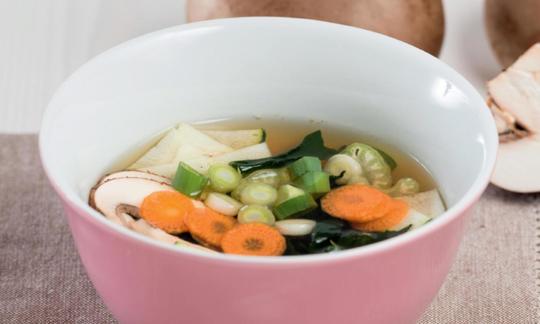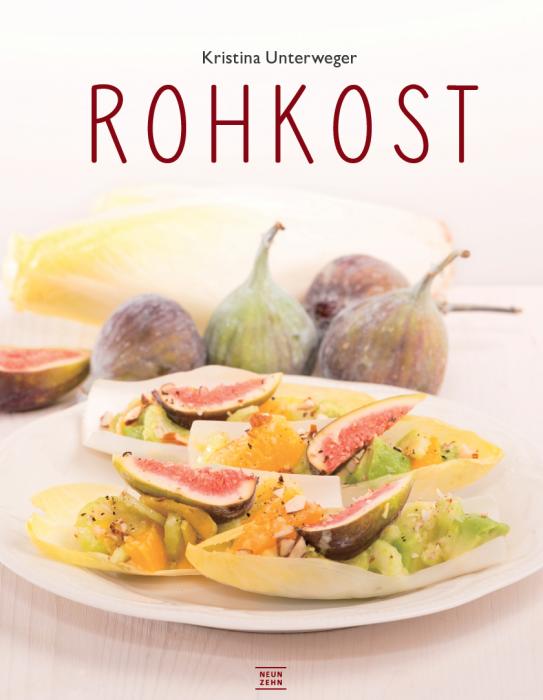Japanese Miso Soup with Zucchini and Carrots
vegan
Ingredients (for servings, )
| For the soup base | |
|---|---|
| 2 | Carrots (carrots), raw (organic?) (4.3 oz) |
| ½ tsp | Ginger, raw (organic?) (0.04 oz) |
| 4 | Cultivated mushrooms, raw (organic?) (2.5 oz) |
| 1 | Zucchini, raw, (organic?) (6.9 oz) |
| ½ | Spring / leek / winter onions, raw, organic? (1.0 oz) |
| 2 stalks | Celery (bleached celery), raw (organic?) (2.1 oz) |
| 2 tbsp | Wakame, raw (organic?) (0.35 oz) |
| For the broth | |
| 1 liter | Drinking water, raw (organic?) (35 oz) |
| 3 tbsp | Reduced salt soy sauce (Genen-Shoyu, organic?, raw?) (1.7 oz) |
| 3 tbsp | Miso (soybean paste) (1.8 oz) |
| For the seasoning and garnish | |
| 1 dash | Table salt (table salt, raw?, organic?) (0.01 oz) |
| 1 dash | Black pepper (organic?, raw?) (0.00 oz) |
| 1 | Limes, raw (organic?) (2.4 oz) |
Equipment
- hand-held blender / immersion blender or blender
- vegetable peeler
- stove
- saucepan
Type of preparation
- cook
- blend
- season to taste
- peel
Preparation
For the soup broth
Peel the carrots and ginger and wash the mushrooms, zucchini, scallions, and celery.
Cut the vegetables into bite-size pieces and finely chop the ginger. Divide the wakame equally into the soup bowls.
As an alternative to wakame, you can use a sheet of nori. Simply tear it into small pieces and divide into the bowls.
Divide the chopped vegetable equally into the soup bowls.
For the broth
Combine the soy sauce and unpasteurized miso with a little water using a fork or an immersion blender to make a broth.We use a low-salt variety soy sauce called genen shoyu whereas the original recipe calls for the gluten-free soy sauce tamari.
Pour the broth into a larger container. Bring the remaining water to a boil and then let cool until the temperature is below 41°C.
For the seasoning and garnish
Combine the warm water with the broth, season to taste with salt and pepper, and pour on top of the vegetables in the individual soup bowls.Garnish each serving with a lemon wedge and serve the Japanese miso soup while it is still warm.
|
Nutritional Information per person
Convert per 100g
|
2000 kcal | |
|---|---|---|
| Energy | 72 kcal | 3.6% |
| Fat/Lipids | 1.1 g | 1.6% |
| Saturated Fats | 0.21 g | 1.0% |
| Carbohydrates (inc.dietary fiber) | 12 g | 4.5% |
| Sugars | 4.9 g | 5.4% |
| Fiber | 3.1 g | 12.5% |
| Protein/Albumin | 4.5 g | 9.1% |
| Cooking Salt (Na:964.5 mg) | 2'450 mg | 102.1% |
| Essential micronutrients with the highest proportions | per person | 2000 kcal | |
|---|---|---|---|
| Sodium, Na | 964 mg | 121.0% | |
| Min | Iod, I (Jod, J) | 109 µg | 73.0% |
| Vit | Vitamin K | 30 µg | 40.0% |
| Vit | Vitamin A, as RAE | 268 µg | 33.0% |
| Vit | Vitamin C (ascorbic acid) | 18 mg | 22.0% |
| Min | Copper, Cu | 0.21 mg | 21.0% |
| Vit | Vitamin B9, B11 (Folate, as the active form of folic acid) | 39 µg | 20.0% |
| Elem | Potassium, K | 388 mg | 19.0% |
| Prot | Threonine (Thr, T, irreversibly transaminated) | 0.16 g | 18.0% |
| Min | Manganese, Mn | 0.32 mg | 16.0% |
Detailed Nutritional Information per Person for this Recipe
The majority of the nutritional information comes from the USDA (US Department of Agriculture). This means that the information for natural products is often incomplete or only given within broader categories, whereas in most cases products made from these have more complete information displayed.
If we take flaxseed, for example, the important essential amino acid ALA (omega-3) is only included in an overarching category whereas for flaxseed oil ALA is listed specifically. In time, we will be able to change this, but it will require a lot of work. An “i” appears behind ingredients that have been adjusted and an explanation appears when you hover over this symbol.
For Erb Muesli, the original calculations resulted in 48 % of the daily requirement of ALA — but with the correction, we see that the muesli actually covers >100 % of the necessary recommendation for the omega-3 fatty acid ALA. Our goal is to eventually be able to compare the nutritional value of our recipes with those that are used in conventional western lifestyles.
| Essential fatty acids | per person | 2000 kcal |
|---|---|---|
| Alpha-Linolenic acid; ALA; 18:3 omega-3 | 0.09 g | 4.0% |
| Linoleic acid; LA; 18:2 omega-6 | 0.42 g | 4.0% |
| Essential amino acids | per person | 2000 kcal |
|---|---|---|
| Threonine (Thr, T, irreversibly transaminated) | 0.16 g | 18.0% |
| Tryptophan (Trp, W) | 0.04 g | 16.0% |
| Isoleucine (Ile, I) | 0.14 g | 11.0% |
| Valin (Val, V) | 0.17 g | 11.0% |
| Leucine (Leu, L) | 0.21 g | 9.0% |
| Lysine (Lys, K, irreversibly transaminated) | 0.16 g | 9.0% |
| Phenylalanine (Phe, F) | 0.13 g | 8.0% |
| Methionine (Met, M) | 0.04 g | 4.0% |
| Vitamins | per person | 2000 kcal |
|---|---|---|
| Vitamin K | 30 µg | 40.0% |
| Vitamin A, as RAE | 268 µg | 33.0% |
| Vitamin C (ascorbic acid) | 18 mg | 22.0% |
| Vitamin B9, B11 (Folate, as the active form of folic acid) | 39 µg | 20.0% |
| Vitamin B2 (Riboflavin) | 0.19 mg | 14.0% |
| Vitamin B6 (pyridoxine) | 0.19 mg | 14.0% |
| Vitamin B5 (Pantothenic acid) | 0.59 mg | 10.0% |
| Vitamin B3 (Niacin) | 1.4 mg | 9.0% |
| Vitamin B7 (Biotin, ex vitamin H) | 4.4 µg | 9.0% |
| Vitamin B1 (Thiamine) | 0.08 mg | 8.0% |
| Vitamin E, as a-TEs | 0.41 mg | 3.0% |
| Vitamin D | 0.04 µg | 1.0% |
| Vitamin B12 (Cobalamin) | 0.02 µg | 1.0% |
| Essential macroelements (macronutrients) | per person | 2000 kcal |
|---|---|---|
| Sodium, Na | 964 mg | 121.0% |
| Potassium, K | 388 mg | 19.0% |
| Phosphorus, P | 76 mg | 11.0% |
| Magnesium, Mg | 30 mg | 8.0% |
| Calcium, Ca | 54 mg | 7.0% |
| Essential trace elements (micronutrients) | per person | 2000 kcal |
|---|---|---|
| Iod, I (Jod, J) | 109 µg | 73.0% |
| Copper, Cu | 0.21 mg | 21.0% |
| Manganese, Mn | 0.32 mg | 16.0% |
| Zinc, Zn | 0.75 mg | 8.0% |
| Iron, Fe | 0.98 mg | 7.0% |
| Fluorine, F | 184 µg | 5.0% |
| Selenium, Se | 2.9 µg | 5.0% |
The book "Raw Food" is a raw food recipe book for beginners and advanced cooks, as many recipes are simple and have a short introduction.
Since this book is written in German, a description is omitted here. If you are interested, please switch to German in the menu.
Miso soup is a traditional Japanese dish. Its unique flavor comes from the fermented soybean paste (miso) and here with with zucchini and carrots.
Iodine and algae: With algae, you should look and see how much iodine it contains. Iodine is an essential trace element that occurs primarily in the form of iodide and is especially important for the production of certain thyroid hormones. A deficiency can cause hypothyroidism, but if you consume too much it can overburden your thyroid and be harmful to your health. The type of iodine found in algae depends on the type of algae, time of harvest, location, and processing.
We don’t consider soy sauce or miso to be raw. Soybeans are generally heated during the production process since green beans of all types contain the glycoprotein phasin, which is toxic for humans. Phasin inhibits the absorption of nutrients in the intestine, causes hemagglutination (clumping of the red blood cells), and in larger amounts can destroy the intestinal villi. Heating processes (e.g., cooking and roasting) destroy phasin and make soybeans and soybean products such as tofu, miso, and tempeh edible for humans. As a result, even unpasteurized soy products are not actually raw, but are instead cooked products that have been “revived” through the process of fermentation.
But at least one brand claims (with two years fermentation and without pasteurization) that its soy sauce is raw. On Soyana’s website, for example, we find the claim “SUITABLE FOR RAW FOOD even though the beans are cooked at the beginning of the production process and are then only ’revived’ via fermentation and not heated again.
I hope this explanation will be helpful for you and will make it clear that these outstanding fermented foods from Soyana have not been reheated but were cooked at the beginning of the process.”
This information should help you understand why we label this recipe as vegan cooked food even though it is listed as raw food in the cookbook it comes from. As a result of the high salt content, we do not regard the recipe to be “especially healthy.”
High salt content: The higher salt content is primarily a result of the soy sauce (tamari) and miso contained in the soup. Consuming too much salt is very unhealthy and it is best to reduce the amount of salt you consume. A total of 2.5 g of table salt (1 g of sodium) per day is optimal, especially if you have high blood pressure. For an adult, ten tablespoons of pure table salt would be lethal. (You can click on the ingredient salt to read more).
Peeling ginger: It works best to peel ginger using the sharp outer edge of a spoon. With the outer edge of the spoon, you can scrape off only the brown skin and none of the inner yellow part is wasted.
Alternative to wakame: You can use nori sheets instead of wakame.




